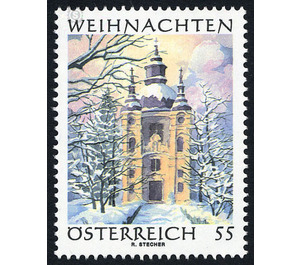Christmas - Austria / II. Republic of Austria 2006 - 55 Euro Cent
Theme: Architecture
| Country | Austria / II. Republic of Austria |
| Issue Date | 2006 |
| Face Value | 55.00 |
| Edition Issued | 5,000,000 |
| Printing Type | Photogravure |
| Stamp Type | Commemorative |
| Item Type | Stamp |
| Chronological Issue Number | 1962 |
| Chronological Chapter | OOS-OE2 |
| SID | 863121 |
| In 71 Wishlists | |
As in 2005, a watercolor painting of the popular old bishop of Innsbruck, Dr. med. Reinhold Stecher, selected. This time it is the pilgrimage church of Christkindl, which the amateur painter has captured on his sketchbook in the winter ambience - a mood that does not fit better for the Christmas season. The baroque façade already graced the stamp of the 2 Schilling-end-stamp from the year 1958 and it also served as a background for the Christmas-mark in 1995. The pilgrimage church "Zum Christkind unterm Himmel" owes its name to the place, to whose municipality the church originally belonged. on the other hand also the genesis legend. The property on which the Christkindl pilgrimage church was built and around which the town of the same name developed over time, is located near the town of Unterhimmel, which was mentioned in 1577 as "Unnderm Himl". Politically, Unterhimmel belonged to the municipality of Garsten. At the time of the founding of the church, the owner of the Benedictine monastery was Garsten, whose abbot Anselm Angerer (1683-1715) also commissioned the Italian architect Giovanni Battista Carlone to build the church against the bishop's resistance in Passau. Carlone died in the year the foundation stone was laid in 1708. Abbot Jakob Prandtauer (1660-1726), who also worked as a master builder in the monastery of Garsten, was involved in the further construction and completion of the project. In 1786 the monastery Garsten was dissolved by Emperor Joseph II and Christkindl declared an independent parish. The monastery Garsten serves since 1851 as a penal institution. The part of the place Christkindl around the church was incorporated 1938 into the city Steyr. The founding legend of Christkindl tells us about a Ferdinand Sertl, Mesner and Türmer of Steyr, who was suffering from epilepsy. In 1695, he set up a 10 cm Christ child figure made of wax in the hollow of a spruce on the right bank of the Steyr and made a pilgrimage almost daily to pray for his recovery in prayer. After a few years, the Mesner seemed to have overcome his suffering. The "healing" got around. Soon the Christ child in the tree in the open air became the target of many seekers of help. For the time being, a small wooden church was built around the spruce trunk, which carried the Christ child out of wax. The crowd of pilgrims finally encouraged the Abbot of Stift Garsten to build the pilgrimage church. Christkindl became world famous through the post office. On December 15, 1950, the post office Christkindl opened its doors for the first time. Since then, every year millions of letters have been sent through the "most romantic post office in the world". At first it was housed in a tiny restaurant in the vicarage, but soon moved to a nearby inn in the inn, where it still has its pre-Christmas home.


